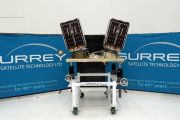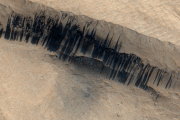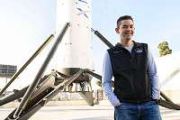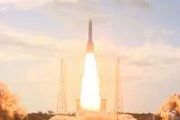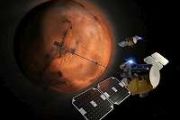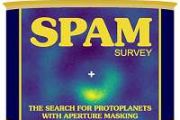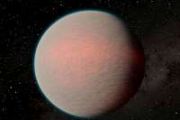
Copernical Team
New ESO observations show rocky exoplanet has just half the mass of Venus
 A team of astronomers have used the European Southern Observatory's Very Large Telescope (ESO's VLT) in Chile to shed new light on planets around a nearby star, L 98-59, that resemble those in the inner Solar System. Amongst the findings are a planet with half the mass of Venus - the lightest exoplanet ever to be measured using the radial velocity technique - an ocean world, and a possible plane
A team of astronomers have used the European Southern Observatory's Very Large Telescope (ESO's VLT) in Chile to shed new light on planets around a nearby star, L 98-59, that resemble those in the inner Solar System. Amongst the findings are a planet with half the mass of Venus - the lightest exoplanet ever to be measured using the radial velocity technique - an ocean world, and a possible plane Scientists Have New Data on the Nearest Planet to the Sun
 An international team of planetary scientists from Russia, Finland, and the United States has analyzed for the first time the factors that determine the number of boulders on the surface of the nearest planet to the Sun, Mercury. Boulders are fragments of rock that form as a result of meteorite impacts on the planet's surface and are located in areas of fresh impact craters hundreds of meters in
An international team of planetary scientists from Russia, Finland, and the United States has analyzed for the first time the factors that determine the number of boulders on the surface of the nearest planet to the Sun, Mercury. Boulders are fragments of rock that form as a result of meteorite impacts on the planet's surface and are located in areas of fresh impact craters hundreds of meters in Astronomers find evidence of possible life-sustaining planet
 Astronomers have found signs of a planet that may have a life-supporting atmosphere, according to a study published Thursday.
The study, published in Astronomy & Astrophysics, focuses on a planetary system named after the star it orbits, L 98-59, according to a press release. Using the European Southern Observatory's Very Large Telescope in Chile, the team of astronomers found a roc
Astronomers have found signs of a planet that may have a life-supporting atmosphere, according to a study published Thursday.
The study, published in Astronomy & Astrophysics, focuses on a planetary system named after the star it orbits, L 98-59, according to a press release. Using the European Southern Observatory's Very Large Telescope in Chile, the team of astronomers found a roc NASA begins recruitment for long-duration Mars Mission Analog Study
 As NASA ventures farther into the cosmos, the astronaut experience will change. In preparation for the real-life challenges of future missions to Mars, NASA will study how highly motivated individuals respond under the rigor of a long-duration, ground-based simulation.
NASA is now accepting applications for participation as a crew member during the first one-year analog mission in a habita
As NASA ventures farther into the cosmos, the astronaut experience will change. In preparation for the real-life challenges of future missions to Mars, NASA will study how highly motivated individuals respond under the rigor of a long-duration, ground-based simulation.
NASA is now accepting applications for participation as a crew member during the first one-year analog mission in a habita Hi-res measurements of asteroid surface temperatures obtained from Earth
 A close examination of the millimeter-wavelength emissions from the asteroid Psyche, which NASA intends to visit in 2026, has produced the first temperature map of the object, providing new insight into its surface properties. The findings, described in a paper published in Planetary Science Journal (PSJ) on August 5, are a step toward resolving the mystery of the origin of this unusual object,
A close examination of the millimeter-wavelength emissions from the asteroid Psyche, which NASA intends to visit in 2026, has produced the first temperature map of the object, providing new insight into its surface properties. The findings, described in a paper published in Planetary Science Journal (PSJ) on August 5, are a step toward resolving the mystery of the origin of this unusual object, Mars rock drilling begins after NASA's helicopter helps plan rover's route
 Aided by the latest photos from Mars helicopter Ingenuity, NASA's robotic rover Perseverance prepared to drill its first rock sample, the space agency said.
The agency decided the drilling will occur at an area called Crater Floor Fractured Rough. NASA planned to send the first signals Thursday to start the drilling process, which could take several days, according to the agency.
Aided by the latest photos from Mars helicopter Ingenuity, NASA's robotic rover Perseverance prepared to drill its first rock sample, the space agency said.
The agency decided the drilling will occur at an area called Crater Floor Fractured Rough. NASA planned to send the first signals Thursday to start the drilling process, which could take several days, according to the agency. NASA is recruiting for yearlong simulated Mars Mission
 Mars is calling! NASA is seeking applicants for participation as a crew member during the first one-year analog mission in a habitat to simulate life on a distant world, set to begin in Fall 2022.
As NASA ventures farther into the cosmos, the astronaut experience will change. In preparation for the real-life challenges of future missions to Mars, NASA will study how highly motivated indivi
Mars is calling! NASA is seeking applicants for participation as a crew member during the first one-year analog mission in a habitat to simulate life on a distant world, set to begin in Fall 2022.
As NASA ventures farther into the cosmos, the astronaut experience will change. In preparation for the real-life challenges of future missions to Mars, NASA will study how highly motivated indivi NASA continues RS-25 testing with 6th installment at Stennis
 NASA conducted its sixth RS-25 single-engine hot fire Aug. 5 on the A-1 Test Stand at Stennis Space Center near Bay St. Louis, Mississippi, a continuation of its seven-part test series to support development and production of engines for the agency's Space Launch System (SLS) rocket on future missions to the Moon.
Operators fired the engine for more than eight minutes (500 seconds), the sa
NASA conducted its sixth RS-25 single-engine hot fire Aug. 5 on the A-1 Test Stand at Stennis Space Center near Bay St. Louis, Mississippi, a continuation of its seven-part test series to support development and production of engines for the agency's Space Launch System (SLS) rocket on future missions to the Moon.
Operators fired the engine for more than eight minutes (500 seconds), the sa SpaceX briefly puts together largest rocket in history at Texas base
 SpaceX briefly constructed the largest rocket ever made Friday, attaching the U.S. aerospace company's Starship spacecraft to the Super Heavy booster at its facility in Texas.
The combined height of the structure was 400 feet, nearly 40 feet taller than the next largest Saturn V rocket built by NASA.
The SpaceX rocket, though, will have about twice as much thrust as Saturn V, 70
SpaceX briefly constructed the largest rocket ever made Friday, attaching the U.S. aerospace company's Starship spacecraft to the Super Heavy booster at its facility in Texas.
The combined height of the structure was 400 feet, nearly 40 feet taller than the next largest Saturn V rocket built by NASA.
The SpaceX rocket, though, will have about twice as much thrust as Saturn V, 70 Virgin Galactic restarting space tickets from $450,000
 After flying its founder Richard Branson to space, Virgin Galactic is restarting ticket sales beginning at $450,000, the company announced Thursday.
The new price is about double the $200,000 to $250,000 paid by around 600 people who previously booked seats on Virgin's spaceship between 2005 and 2014, as the company looks to cash in on the success of last month's fully-crewed test flight.
After flying its founder Richard Branson to space, Virgin Galactic is restarting ticket sales beginning at $450,000, the company announced Thursday.
The new price is about double the $200,000 to $250,000 paid by around 600 people who previously booked seats on Virgin's spaceship between 2005 and 2014, as the company looks to cash in on the success of last month's fully-crewed test flight. 




